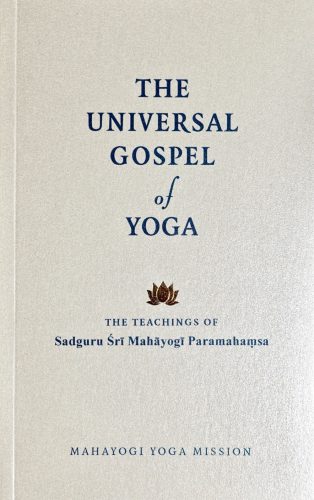
Sky above Clouds IV, 1965 by Georgia O’Keeffe
Talk at the End of the Asana & Meditation Class
Sunday, May 1st 2022
The Practice of Making Persistent Effort to Restrain the Mind
Can Continue Any Time, Any Place, No Matter What’s Happening
 “…Simply put, when the mind becomes still,
“…Simply put, when the mind becomes still,
it will be revealed to you that You are God.”
—Satguru Shri Mahayogi Paramahansa
from “The Aim of Life” in The Universal Gospel of Yoga
Teachers sometimes go on overnight trips with their students. This past week I attended a two-day trip with 4th and 5th graders (ages 9 -11) to a nature center in Upstate, New York, where they can engage in outdoor activities, such as hiking, wildlife exploration, blacksmithing and archery. In total, there were about sixty students. As the trip approached, I tried to mentally prepare myself. Normally, I have a pretty steady routine of asana and meditation, reading scriptures, conversations with sangha, and I have been trying to practice discrimination during daily life. For this trip, I was aware that my entire time for these two days would be dedicated to the students from early in the morning till late at night, so a few days before leaving I began to wonder how I would continue practicing Yoga, but I did not make a specific plan.
Since during the trip I was going to spend uninterrupted time with the students in a more relaxed manner, I took a little time to think about some teachings that might be good to share with them, or to at least try. For example, I thought about sharing with them the teaching of equality and how every single living and non-living thing is precious and valuable, or perhaps, I could speak with them about contentment (santosha), how to be content with the minimum amount of things and the joy that can come of that, or maybe simply how true happiness can come from giving selflessly to others. I was not sure how or when, but those were some of the general thoughts that I had in my mind.
Then reality came. As soon as the children felt the expansiveness and open space of 345 green acres (139.62 hectares) of land, well, as might happen with us adults too, they became very excited and wanted to run around freely! This sense of freedom came with many emotions: some were over-excited, and at times created some dangers to themselves and others, some were scared and nervous about running up against a wild animal or experiencing the natural elements, and some quickly focused on the social opportunities of being in a new environment around so many friends at one time. The energy was high every single moment. On the surface they all looked busy, engaged, and entertained. But, along with all the activity, conflicts arose. Feelings were hurt as they began to feel threatened by being excluded, not appreciated, being ridiculed, or by the threat of losing the attention of a close friend. During some activities, competition became fierce and hurtful, causing other shifts in the dynamics among them. I was observing the drama of life in its full gamma, spinning around from one state to another, and it reminded me of the three qualities described by Shri Mahayogi and in the Yoga Sutra, called the guna: rajas (quality of discomfort, agitation and restlessness), tamas (quality of inertia, characterized by heaviness), and perhaps even some moments that approximated sattva (quality of comfort, lightness and brilliance) here and there. And, it was not only students, I noticed that we adults, too, would fluctuate between these qualities, just like the children and along with them.
All my idealistic notions about sharing the teachings of Yoga disappeared very quickly and instead I found myself remembering something that Shri Mahayogi once told a small group of sangha when we spoke to him about our interest to create opportunities to lead young people to experience Yoga, and Shri Mahayogi mentioned that the most important thing is the inner state of the person leading. So, given the situation, I decided that the most important work for me was to focus on my inner state. When I did this, I was wondering what I should be looking for inside myself. I needed a direction, so I decided that it may be helpful to look for the stillness that is within, which Shri Mahayogi describes as unaffected by any conditions. I thought this would help me keep myself from being pulled in by the rampant emotions of the children (and my own too!). I thought of this stillness as a place inside of me where all reactions fizzle away—a place where the mind is unresponsive to any triggers. In other words, a peaceful place. I figured that if I could keep myself close to that stillness or at least focus on pointing toward it by restraining my mind, then I could probably feel steadier myself and possibly help the students be more at ease somehow.
Over and over, I tried to get closer to that space of stillness inside me, consciously taking a step back every time I noticed a reaction or emotion wanting to pull me away from it. After doing this for the first day, I started to notice that it was also possible to sense that, beyond the many emotions and constant activity, there also was stillness in everyone else. I cannot explain exactly how I sensed that, but I remember that the busyness began to appear as if it was only on the surface, or as if it was being projected on a movie screen, and not real, and the stillness existed behind, constantly there. Sensing that the busyness was only superficial offered me more mental and emotional distance, the space for being at ease and for making quick decisions while participating in situations around me. Maybe it was because there was so much to do constantly that I felt the need to detach from the emotions—I do not know for sure—but the fact is that I had no time to think about whether this way of practicing was working or not, or about what specific effects it had. I had to be on my feet, doing this and that, taking care of so many matters with children, and adults too, that I could not really afford to take away my attention from the situations in front of me, one after another, or from the effort to search for stillness within myself anytime my mind was running the risk of being dragged by emotions and situations. These two simultaneous focuses, managing situations on the outside and searching for stillness inside, took up all my concentration.
At some point, toward the end of our trip, however, I realized that what was unique about this trip was that I began to feel the students, most of whom I have known for the whole school year, much closer to me—as if we were relating to each other from the inside rather than from the outside. More than that, each one, even the ones that I did not have a chance to speak directly with that much, began to feel so precious and loving to me during this trip. Surprisingly, this new way of relating to them brought deep gratefulness for everyone and everything around me, and strangely for me, it felt unconditional, toward the students who were troublesome, the ones who were overexcited and loud, the ones who were frightened or shy, the teachers who complained and the ones who did not, and I even felt this way toward the elements and situations around me, the cold wind chapping my lips and the textures, smells and sounds of nature and of the children too—all of it. It all felt rather like a gift, a great fortune, and an opportunity.
I have the impression now that the more I try to bring my mind toward stillness, the less it will feel threatened or bothered by the turmoil or activity outside. I realize now that by trying to persist in the effort to restrain the mind, that practice can continue any time, any place, no matter what is happening. I was concerned about not having time or mental space to practice asana and meditation, to read scriptures, or to continue with discrimination, but in the end, ironically, this experience turned out to be an opportunity for practicing Yoga, because it created the need to aim with stronger intention toward seeking the stillness within each moment. I believe that this is what Shri Mahayogi has always been reminding us about what Yoga is: stilling the mind completely so we can fully experience what is beyond—the Truth, or God; like the Psalm expresses, “Be still and know that I am God.” I hope that this new discovery of how to practice Yoga within, regardless of the conditions, will continue to expand and establish itself, and lead me toward the Truth that Shri Mahayogi assures us is there waiting to be known.
~Karuna
To make a financial contribution, visit our CONTRIBUTION PAGE.
Visit and share our WELCOME PAGE to join our online classes.
